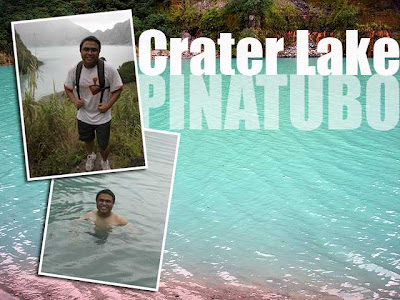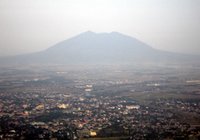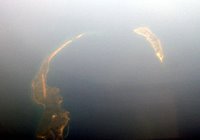 Corregidor is not just a memorial to the heroism during the Second World War. Today, it's truly a destination. And I hope it gets more attention. Just two weeks after my recent day-trip to Corregidor, I decided to come back, this time for an overnight trip and more exploration. I tagged along Gideon so he could map out some trekking routes.
Corregidor is not just a memorial to the heroism during the Second World War. Today, it's truly a destination. And I hope it gets more attention. Just two weeks after my recent day-trip to Corregidor, I decided to come back, this time for an overnight trip and more exploration. I tagged along Gideon so he could map out some trekking routes.I wanted to see all the attractions off the usual tour route, especially the artillery batteries off the beaten track. And when you stay overnight in Corregidor, you can do a lateral tunnel tour in total darkness! And I'll make sure I do that!
We took the first Sun Cruises trip to the island. I slept the whole trip going there and the whole morning at the Corregidor Inn since I did not have any sleep the night before. So Gideon hiked up Malinta Hill on his own.
 After lunch, we hired our own vehicle so that we could check out the different artillery batteries at our own pace. First stop was Battery Morrison. The grass was a bit tall and obviously, it wasn't that visited. Battery James is nearby. But what remains is just the concrete structure. It's gun, like in most of the gun batteries near the shore, have been stolen and sold for scrap. It's really sad hearing these stories of theft.
After lunch, we hired our own vehicle so that we could check out the different artillery batteries at our own pace. First stop was Battery Morrison. The grass was a bit tall and obviously, it wasn't that visited. Battery James is nearby. But what remains is just the concrete structure. It's gun, like in most of the gun batteries near the shore, have been stolen and sold for scrap. It's really sad hearing these stories of theft. We also visited Battery Way and Battery Hearn which is on the regular tourist route. What people don't know is that Battery Hearn has a twin called Battery Smith. In fact, Hearn was part of Smith before it was renamed Hearn.
We also visited Battery Way and Battery Hearn which is on the regular tourist route. What people don't know is that Battery Hearn has a twin called Battery Smith. In fact, Hearn was part of Smith before it was renamed Hearn.

 We then visited Battery Wheeler which reminded me of Battery Grubbs. Battery Geary is also popular because it still has live ammunition stuck inside it even after it was hit and exploded during the war. Just a few meters away from it is Battery Crockett.
We then visited Battery Wheeler which reminded me of Battery Grubbs. Battery Geary is also popular because it still has live ammunition stuck inside it even after it was hit and exploded during the war. Just a few meters away from it is Battery Crockett. The last Corregidor gun battery we visited today was Battery Ramsey. There was nothing much left of it since it got hit as well during the war. But at least parts of the gun are still there. I took a nap the rest of the afternoon. If you want peace and quiet, Corregidor is definitely a good candidate.
The last Corregidor gun battery we visited today was Battery Ramsey. There was nothing much left of it since it got hit as well during the war. But at least parts of the gun are still there. I took a nap the rest of the afternoon. If you want peace and quiet, Corregidor is definitely a good candidate.My plan was to join the night tour of Malinta Tunnel lateral tunnels. But that was canceled since it was raining and the other guests at the hotel decided not to push through. So let's just say I got to sleep early that night.
The next day, I was off to more exploration. I finally got to visit Kindley Airfield near the tail of Corregidor Island. It's the site of the infamous Jabidah Massacre which saw dozens of young Muslim trainees slaughtered to protect a military secret. It would have been lost in history had one of the youth not survived to tell the tale.
 There was one gun battery with its guns still intact. And that's Battery Cheney. But to get to it, you have to hike a bit and you'll have to go through some tall grass. But that was fine with me. It also reminded me of Grubbs and Crockett.
There was one gun battery with its guns still intact. And that's Battery Cheney. But to get to it, you have to hike a bit and you'll have to go through some tall grass. But that was fine with me. It also reminded me of Grubbs and Crockett.On the way there, you'll see some Japanese caves by the beach. there are many of these holes all over Corregidor which the Japanese built to protect themselves from attack.
 Anyway, I decided to push through with my Malinta Tunnel tour now that it wasn't raining. Even if you do it during the daytime, the place is pitch black. So you could imagine what the soldiers and their families had to go through during the war, especially when there was no power.
Anyway, I decided to push through with my Malinta Tunnel tour now that it wasn't raining. Even if you do it during the daytime, the place is pitch black. So you could imagine what the soldiers and their families had to go through during the war, especially when there was no power.It was a good thing I was wearing a hard hat since I bumped my head several times! Some of the tunnels are really narrow and low, especially those which were damaged during the liberation of Corregidor. We got to visit the hospital as well. My guide pointed to a large wooden door with grills which served as a prison for those caught stealing the guns.
The overnight trip was really fun and most definitely worth it. I want to come back again to explore more of the island. Maybe they could establish more trails which people could visit. And I hope Sun Cruises opens up more ferry schedules so that people could visit the island anytime they want.
Part 1: Corregidor Island day trip via Sun Cruises

























